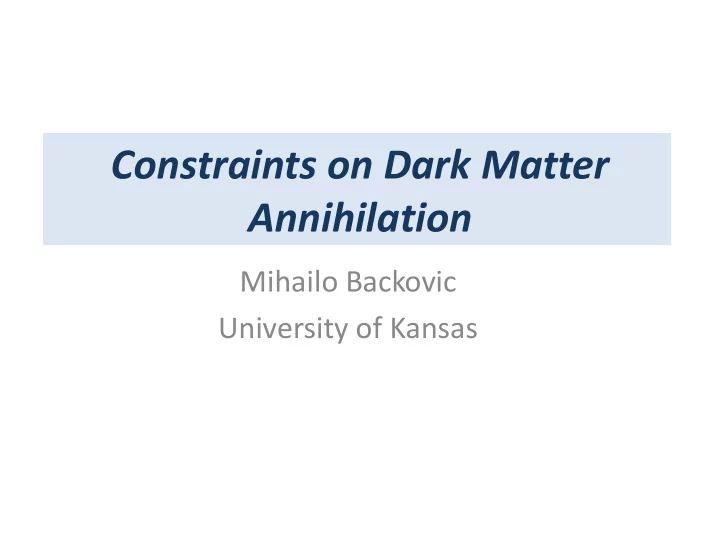

Constraints on Dark Matter Annihilation Mihailo Backovic University of Kansas
Dark Matter Annihilation – Early Universe • For constant velocity averaged cross sections relic abundance predicts: • In general, cross sections are more complicated: – Higher order corrections are dependent on the energy! (think infra-red divergences for example) – Breit-Wigners have non-trivial energy dependence. – … • More interesting relic abundance inspired relations possible. • Let’s look at s -channel annihilation
S-channel annihilation cross section X Y X By the Optical Theorem: • Includes propagator corrections to ALL ORDERS in pert. theory • Includes ALL POSSIBLE number or type of final states • We consider ALL types of initial states. Relic calculation non-trivial analytically! Recall: it includes integration over all energies and the entire thermal history of the universe! Also, multiple scale problem!
Relic abundance predicts NEW mass- width relations for • We are interested in the relations between parameters ( ) NUMERICAL 1. For a given and , produces a unique curve in the ( ) space. (Black dashed line - numerical) Constant relic abundance does not give you a number for the cross section It gives you a relationship between the parameters . More challenging!
A formula is worth a 1000 numerical calculations • Analytic s-channel relic calculation complicated! • Good approximation possible! Black/Dashed – Numerical Blue/Solid - Approximation Replaces The approximation relates all 5 parameters of the problem! No need for further numerical calculations!
Calculable widths and immediate results
Widths as calculable features Let: Allows to consider many Couplings, kinematics, etc. models at once Consistency occurs at the intersection of red lines with lines representing constant relic abundance.
Small Width Limit: Poles near Threshold and Fine Tuning This is a pretty strong coupling. Weaker couplings pushes the Blue/Black lines up. Small widths force the pole into a finely Green regions are tuned region near threshold NOT finely tuned
Heavy Dark Matter Limit Another New Fine Tuning Problem Allows for a relation between the mass of Y and mass of X Large m x
Example: Z’ search at the LHC Could Y (LHC) be the Y(DM)? Consistent param. regions? … if dark matter dominantly annihilated into Y No Numerical Calculation Necessary!
Example: Z’ search at the LHC • What if more DM annihilation channels contribute? • Assume no large destructive interference terms. Shaded region to the left of the curve is not allowed Half of parameter space cut off with no need for parameter space search.
Indirect Detection (Backup slides)
Upper limits on s-channel annihilation in the halo • Useful parameterization (wrt. the energy scale of the halo): Backovic, Ralston arXiv: 0910.1113
Annihilation through a bound state Condition for a bound state: Hydrogen-like bound states will roughly be described by: A>0 Backovic, Ralston arXiv: 0910.1113
Upper limits on s-channel annihilation in the halo • Any simple pole • Bound state • Neutrino limit (Beacom, Bell, Mack arXiv:astro-ph/0608090v2) • Unitarity bound • Lower bound from cosmology Large enhancements possible, but fine tuning required to saturate upper limits! Backovic, Ralston arXiv: 0910.1113
Thank you!
Recommend
More recommend